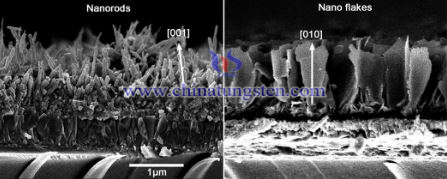Tungsten Trioxide Nanostructures for Solar Energy Conversion
- Details
- Category: Tungsten Information
- Published on Thursday, 30 June 2016 15:57
Photoelectrochemical water splitting, where irradiation of a photoelectrode in water produces hydrogen and oxygen, can be used for solar energy harvesting and conversion. The process potentially offers a clean, sustainable, and large-scale energy resource. Photoanodes used in the photoelectrochemical process are generally made from Earth-abundant oxide semiconductors, such as titanium dioxide, tungsten trioxide, and iron (III) oxide. Among these metal oxide semiconductors, tungsten trioxide is regarded as one of the best candidates because of its visible light-driven photocatalytic activity, its good charge transport properties, and its relative stability in aqueous electrolytes. However, the light absorption and charge collection efficiency of tungsten trioxide—especially within a bulk structure—still needs to be improved to realize practical photoelectrochemical applications.
To further improve the transport efficiency of tungsten trioxide (and other semiconductors), low-dimensional structures have specifically been identified as offering direct electrical pathways for photogenerated carriers. These structures feature reduced grain boundaries that enable superior charge transport efficiency. The synthesis of low-dimensional semiconductor nanoarchitectures by low-cost synthetic procedures (e.g., a hydrothermal approach) is therefore a promising method for future large-scale implementation of photoelectrochemical water splitting and clean energy production. In particular, the morphologies and structures of catalysts are important parameters in photoelectrochemical applications. Tungsten trioxide thin films with various morphologies have previously been reported, and are widely used in electrochromic, field-emission, gas-sensing, and photoelectrochemical water-splitting devices.
(Arrays of tungsten trioxide nanorods (left) and nanoflakes (right) that were grown on fluorine-doped tin oxide-coated glass, through the use of a solvothermal technique. )
In our recent work we have therefore focused on hydrothermal synthesis of low-dimensional tungsten trioxide nanostructures for photoelectrochemical applications. We have developed a simple method for the deposition of ordered arrays of tungsten trioxide nanowires and nanoflakes on fluorine-doped tin oxide (FTO)-coated glass. In this approach, we use a solvothermal technique, which involves the crystallization of a solution at high temperature and pressure. To demonstrate this technique, we used a tungsten trioxide seed layer to initiate growth and we tailored the geometries by adjusting the composition of the hydrothermal precursor. We can grow hexagonal tungsten trioxide nanowire and monoclinic nanoflake arrays in the or crystallographic directions, and we can tailor the wires and arrays by adjusting the solution composition. After the annealing process, we found that the samples exhibited further reductions in their band gaps, which improved the photocurrents significantly. We attribute this change in electronic band gap to the distortion of the tungsten trioxide crystal structure's octahedral building blocks, which occurs during annealing. Our solvothermal film growth technique is thus an exciting development for the fabrication of 1D metal oxide nanostructures that may enable practical applications in photoelectrochemical energy conversion.
| Tungsten Oxide Supplier: Chinatungsten Online www.tungsten-oxide.com | Tel.: 86 592 5129696; Fax: 86 592 5129797;Email:sales@chinatungsten.com |
| Tungsten News & Prices, 3G Version: http://3g.chinatungsten.com | Molybdenum News & Molybdenum Price: http://news.molybdenum.com.cn |




 sales@chinatungsten.com
sales@chinatungsten.com